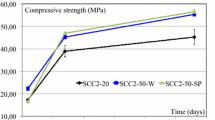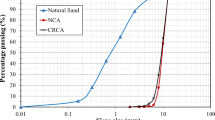Abstract
Since the mix design of self-consolidating concrete (SCC) differs from that of conventional concrete, mechanical properties of SCC may differ from those of vibrated concrete. An experimental program was performed to evaluate mechanical properties of SCC used for precast, prestressed applications. Sixteen SCC mixtures with a fixed slump flow of 680 ± 20 mm were prepared with different mixture parameters, including binder content and binder type, w/cm, dosage of viscosity-modifying admixture, and sand-to-total aggregate volume ratio. Two high-performance concrete mixtures that represent typically concrete used for precast, prestressed applications were investigated for the control mixtures. They were proportioned with 0.34 and 0.38 w/cm and had slump values of 150 mm. Mechanical properties of SCC were compared to code provisions to estimate compressive strength, elastic modulus, and flexural strength. The modified ACI 209-90 and CEB-FIP MC90 codes are found to provide good estimate for compressive strength prediction. The AASHTO 2007 model can provide good prediction of the elastic modulus and flexural strength of SCC.







Similar content being viewed by others
References
ACI Committee 237R-07 (2007) Self-consolidating concrete. American Concrete Institute, Michigan
Kovler K, Roussel N (2011) Properties of fresh and hardened concrete. Cement Concr Res 41(7):775–792
Khayat KH, Long WJ (2010) Shrinkage of precast, prestressed self-consolidating concrete. ACI Mater J 107(3):231–238
Long WJ, Khayat KH (2011) Creep of prestressed self-consolidating concrete. ACI Mater J 108(5):476–484
Vilanova A (2011) Evaluation of the mechanical properties of self-compacting concrete using current estimating models. Constr Building Mater 25(8):3417–3426
Domone PL (2007) A review of the hardened mechanical properties of self-compacting concrete. Cement Concr Compos 29(1):1–12
RILEM Technical Commitee 174-SCC (2000) Self-compacting concrete. In: Skarendahl A, Petersson O (eds) State-of-the-art report 23, 168 p
Swedish Concrete Association (2002) Self-compacting concrete, recommendations for use, concrete report no. 10(E), 84 p
Ye G et al (2007) Numerical simulation of the hydration process and the development of microstructure of self-compacting cement paste containing limestone as filler. RILEM Mater Struct 40(9):865–875
Persson B (1999) Creep, shrinkage and elastic modulus of self-compacting concrete. In: Proceedings of the 1st international RILEM symposium on self-compacting concrete, Stockholm, pp 239–250
Attiogbe EK, See HT, Daczko JA (2002) Engineering properties of self-consolidating concrete. In: Proceedings of the 1st North American conference on the design and use of SCC, Chicago, pp 331–336
Gram HE, Piiparinen P (1999) Properties of SCC—especially early age and long term shrinkage and salt frost resistance. In: Proceedings of the 1st international RILEM symposium on self-compacting concrete. RILEM, Cachan Cedex, pp 211–225
Mokhtarzadeh A, French C (2000) Mechanical properties of high-strength concrete with consideration for precast applications. ACI Mater J 97(2):136–146
Holschemacher K, Klug Y (2002) A database for the evaluation of hardened properties of SCC. Leipzig annual civil engineering report, no. 7, Universität Leipzig, pp 123–134
Vieira M, Bettencourt A (2003) Deformability of hardened SCC. In: Proceedings of the 3rd international RILEM symposium on self-compacting concrete, Reykjavik, pp 637–644
Dehn F, Holschemacher K, Weiße D (2000) Self-compacting concrete time development of the material properties and the bond behavior. The Leipzig annual civil engineering report, Germany LACER, vol 5, pp 115–124
Gibbs J, Bartos PJM, Zhu W, Sonebi M, Tamimi A (2000) Task 4—properties of hardened concrete. Final report of the European SCC project—rational production and improved working environment through using self-compacting concrete, Brite EuRam project BE96-3801, 75 p
Almeida Filho FM, Barragán BE, Casas JR, El Debs ALHC (2010) Hardened properties of self-compacting concrete—a statistical approach. Construct Building Mater 24(9):1608–1615
Turcry P, Loukili A, Haidar K (2002) Mechanical properties, plastic shrinkage and free deformations of self-consolidating concrete. In: Proceedings of the 1st North American conference on the design and use of self-consolidating concrete, Chicago, pp 335–340
Precast/Prestressed Concrete Institute (2003) Interim guidelines for the use of self-consolidating concrete in precast/prestressed concrete institute member plants, 148 p
American Association of State Highway Transportation Officials (AASHTO LRFD) (2004) Bridge design specifications, SI Units, 3rd edn
Erkmen B, Shield CK, French CE (2007) Time-dependent behavior of full-scale self-consolidating concrete precast prestressed girders, SP-247-12, SP-247CD Self-Consolidating Concrete for Precast Prestressed Applications CD-ROM
Ma J, Dietz J (2002) Ultra high performance self-compacting concrete, Leipzig annual civil engineering report no. 7, Universität Leipzig, pp 33–42
Panesar DK, Shindman B (2011) Elastic properties of self-consolidating concrete. Constr Building Mater 25(8):3334–3344
Van Itterbeeck, P, Cauberg N, Parmentier B, Vandewalle L, Lesage K, (2010) Eurocode 2 predictions vs. mechanical properties of self-compacting concrete. In: Proceedings of the design, production, and placement of SCC, Montreal, vol 2, pp 823–832
ACI Committee 209, 209R-92 Reapproved (1997) Prediction of creep, shrinkage, and temperature effects in concrete structure, 47 p
CEB (1993) CEB-FIP Model Code 1990. CEB Bulletin d’Information, No. 213/214, Comité Euro-International du Béton, Lausanne, Switzerland, 437 p
AASHTO, AASHTO LRFD (2007) Bridge design specifications, SI Units, 4th edn, 1518 p
ACI Committee 363, 363R-92 (1997) Report on High-strength concrete, 55 p
ACI Committee 318-99 (1999) Building code requirements for structural concrete with commentary, 391 p
Khayat KH, Bickley JA, Hooton RD (1995) High strength concrete properties derived from compressive strength values. Cement Concr Aggreg 17(2):126–133
Long WJ, Khayat KH (2012) Statistical models to predict fresh and hardened properties of SCC. RILEM Mater Struct 45(7):1035–1052
Acknowledgments
The authors acknowledge the financial support provided by the Transportation Research Board of the National Academies (NAS-NRC) of the United States of America for NCHRP Project 18-12, the National Natural Science Foundation of China (No. 51008197 and 51278306), and the Science Industry Trade and Information Technology Commission of Shenzhen Municipality (No. JC201005280566A). The assistance of Mr. Guillaume Lemieux during this project is especially acknowledged.
Author information
Authors and Affiliations
Corresponding author
Rights and permissions
About this article
Cite this article
Long, WJ., Khayat, K.H. & Hwang, SD. Mechanical properties of prestressed self-consolidating concrete. Mater Struct 46, 1473–1487 (2013). https://doi.org/10.1617/s11527-012-9989-9
Received:
Accepted:
Published:
Issue Date:
DOI: https://doi.org/10.1617/s11527-012-9989-9




